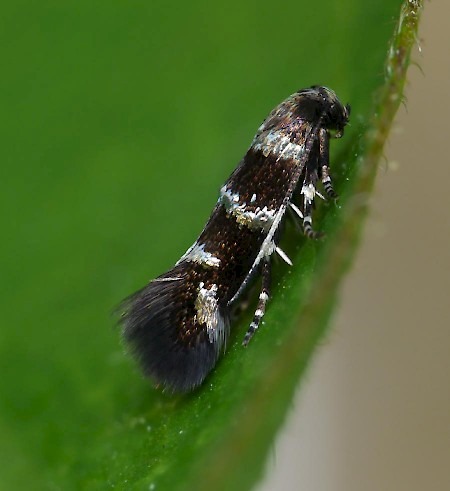
38.003 BF592
Basil Dwarf Stephensia brunnichella
(Linnaeus, 1767)
Wingspan 8–9 mm.
A small attractive species, the Basil Dwarf gets its common name from its aromatic foodplant, wild basil (Clinopodium vulgare). This purple-flowered perennial likes dry, chalky soils and our moth is found where it grows in abundance - especially along the edges of calcareous deciduous woodland. This said, the Basil Dwarf is listed as nationally scarce, occurring infrequently in parts of England and Wales.
The alternating pattern of rich black-browns and bright silvery-white to “brassy” hues, which decorates its forewings, is very distinctive. Upon each forewing is a pale metallic spot at the tip of the leading edge, and a silvery triangular marking near the bottom corner. Trimming the bottom edge of the forewings is a fringe of black-brown cilia. The hindwings are dark grey and sprinkled, here and there, with tiny glistening scales. And finally, distinguishing the Basil Dwarf from many of its Elachista cousins, is the signature white band at three quarters up the length of its antennae.
Adults lay their eggs in the tissue of wild basil leaves, either near the midrib or on the underside towards the base. The pale green larvae, once hatched, mine through the leaf to its tip. Here, the mine will expand to become a conspicuous and ever-widening brown blotch. At this point, the larva may go on to mine other leaves.
Two generations of moths take to the air in a season: one from May to June, and another from August to September.
Description: Michela Sisti

 UKMoths
UKMoths 

